1969 Dutch Grand Prix race report: No match for Matra
Lotus’s Rindt suffers more mechanical gremlins, paving the way for Matra’s Jackie Stewart to win for a third time this season
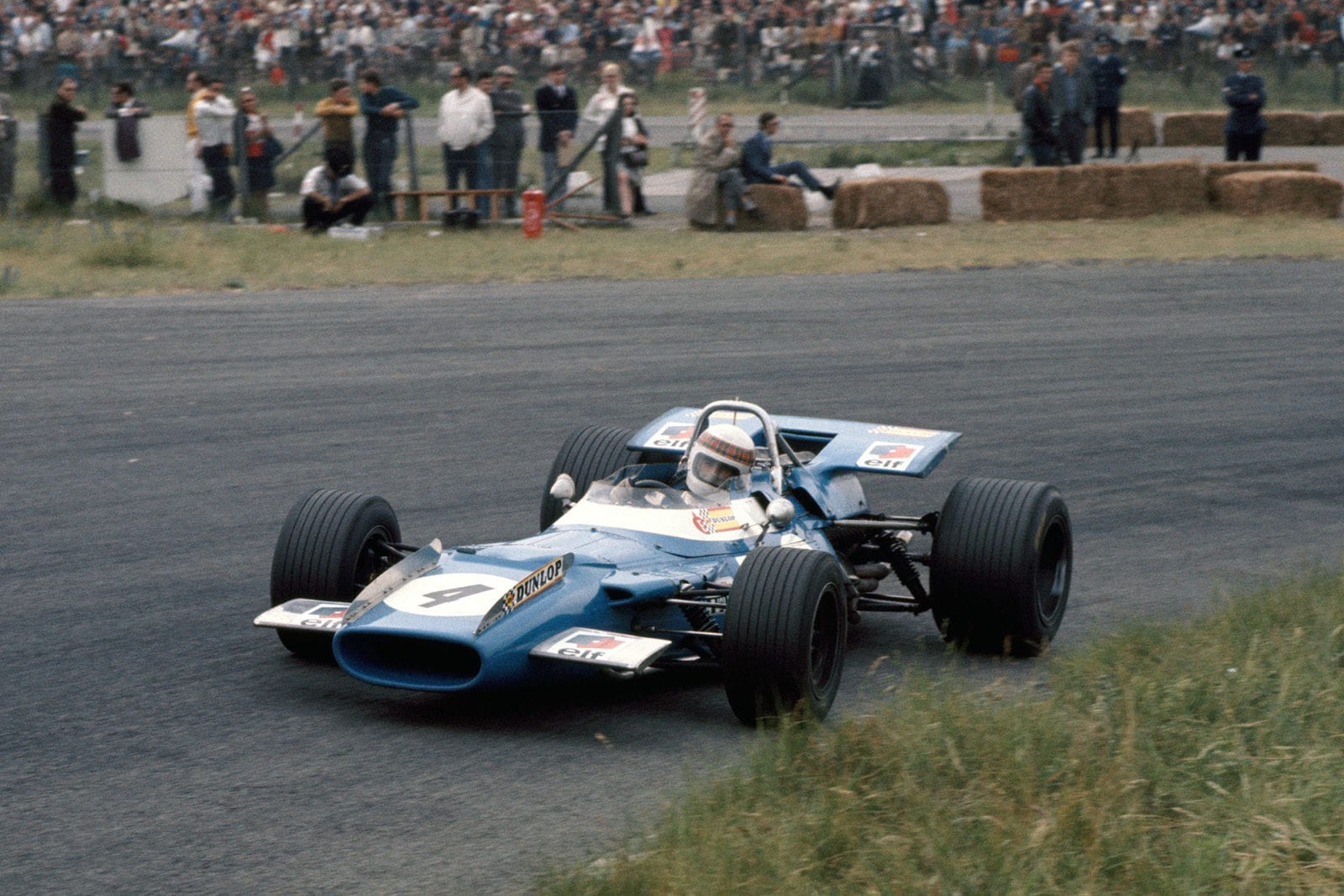
Jackie Stewart claimed his third win in four races
Motorsport Images
If the Dutch Grand Prix is looked at in the overall scene of International rating it was satisfactory enough, with Stewart winning for the second year running for Matra International, some good racings for the lower placings, interesting new cars in practice and some very fast practice and race laps.
If it is looked at closely it shows up in a very different light, being far from satisfactory on many counts. Many of the deficiencies of the Zandvoort circuit and the Dutch organisation have been with us for a long time but in the general excitement of the meeting have been overlooked and forgotten until the next time, or they have been accepted as part of the scene.
The circuit is an artificial one, constructed in sand dunes, and one tends to forget that the road surface is covered by a fine layer of sand, but it was brought home forcibly just before the race when Prince Bernhard of Holland landed alongside the starting line in a helicopter. The rush of air from the rotor raised sand from the track surface in a miniature storm, yet previously the road had looked completely dry and smooth. This sandy property of the track invariably upsets someone’s handling calculation, and many a driver has been content with his car at Monaco for example, and then found he doesn’t like the feel of it at Zandvoort.
The shape of the circuit, like so many, is great fun and very satisfying to drive round if you are on your own, but tiresome if you are behind a competitor who is nearly as fast as you, for if the man in front does not deliberately make room there is nowhere to overtake except down the finishing straight, or under braking for the large-radius hairpin bend at the end of it.
Every year you see someone holding up a group of cars for lap after lap, so that there is a tight procession until someone is brave enough to pass under braking past the pits. The sweeping curves round the back of the circuit are such that it is a case of follow-my-leader through them, there being no straight bits in between the curves to allow overtaking.
Qualifying
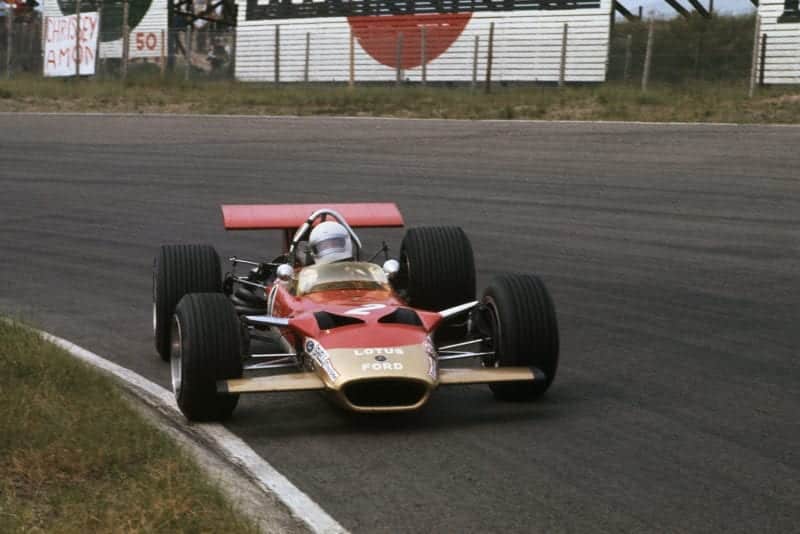
Jochen Rindt set the fastest time in qualifying
Motorsport Images
With today’s Grand Prix cars generating more and more cornering power and taking the curves faster and faster there is less room than ever for passing. If two equal cars are battling it is true to say that the outcome will be decided on braking at the end of the finishing straight. In practice this fact could clearly be seen by watching Siffert, Hill, Rindt or Stewart braking well past the 200-metre signboard from 170mph, while other drivers were braking before 250 metres.
“Another problem from which the Zandvoort circuit suffers, but about which nothing can be done, is the perpetual wind”
Another problem from which the Zandvoort circuit suffers, but about which nothing can be done, is the perpetual wind. Lying within sight of the North Sea the wind blows either off the sea, which is across the finishing straight from left to right, from the land which means from right to left, or it turns through ninety-degrees and blows directly down the straight and with such a force that fast lap times are invariably recorded under these conditions.
This year’s race followed this pattern, with most of the fastest times being made on Friday morning while the wind was turning from seaward to landward; once it had turned there was little chance of Rindt losing his pole position.
The time recording at Zandvoort is done electrically by a beam across the track that records the time of a car passing very accurately to two places of decimals. Visual observation by timekeepers provides the order of cars passing and other timekeepers analyse the instrument recordings and tie them up with each car. Almost every year this system breaks down at some point, sometimes seriously, other times not so seriously, but this year was a serious occasion.
In the second practice session of the meeting, on Friday morning, with a following wind, Rindt recorded a best ever of 1min 20.85sec, trying all he knew and looking pretty wild and uncontrollable. This was pole position by quite a margin as the previous best time had been 1min 21.50sec by Stewart the day before with a cross wind. Shortly before the Friday morning session ended Stewart went out in the second of the MS80 Matras to try and retrieve his position and after a number of laps at just over 1min 21sec his pit signalled him 1min 20.9sec and then he came in having done all he could.
The official times are bound to appear some time after a car has stopped as the timekeepers have to do calculations and when they had done them they gave Stewart 1min 20.41sec. It was received with disbelief by everyone, Stewart and Matra included, and by this time rain had started to fall, and the lunch break began. Later the timekeepers withdrew the 1min 20.41sec for Stewart and substituted 1min 21.14sec, leaving Rindt with pole position, but once again everyone had lost faith in the timekeeping, which was most unsatisfactory.
On another technical point, the Dutch organisers had a difficult decision to make, but came out with flying colours. With the cancellation of the Belgian GP the Dutch race was the first Formula One event since the hasty decision that the CS made on aerofoils at Monaco. All the teams produced their versions of the regulations which said loosely that any aerodynamic assistance must be fixed and part of the bodywork.
McLaren and Matra came up with straightforward honest interpretations of the rules, though McLaren had an alternative that was blatant cheating, and so did BRM, but Ferrari, Lotus and Brabham were stretching the imagination a bit. The Dutch scrutineers had a hard time for the CS wording was very loose, so they accepted those that they felt were in the spirit and rejected those that were a “try-on.”
The McLarens were fitted with a vast flat tray over the engine and it had sides and a turned-up tail, so that it was like a great air-shovel. Hulme also started to have fitted an old-type aerofoil on struts in place of the tray, but mounted as close as possible to the engine and rear suspension but this was turned down.
BRM had curved sheets of aluminium across the back of the car, close to the mechanism, with the four exhaust pipes protruding through a gap in this air-deflector. This was accepted but when they started fitting a pure aerofoil onto short struts the scrutineers put a stop to it.
Matra had the best answer, which was a complete engine cowling that swept up at the end into an aerofoil across the tail, the whole thing beautifully moulded in fibreglass and surrounding the oil cooler.
Brabham had a similar idea, made in aluminium on a tubular frame, with the aerofoil part bolted on and Lotus did likewise except that theirs made no attempt to cover the engine. Ferrari had a simple cover over the oil cooler and exhaust pipes that presented a flat area to wind, with a turned-up tail. The scrutineers were very lenient in the decisions, agreeing that the wording of the CS rule was very loose and ambiguous. One gets the impression that the CS members have no idea of the complexity of thinking of racing car designers, nor their ingenuity and cunning.
“It was no surprise when Matra and Lotus wheeled out their new 4-wheel-drive cars for the first practice”
The Zandvoort circuit is a safe one and fairly easy on the cars and drivers, and it invariably sees the introduction of some new cars. The South African race is too early, Monaco is not a good place for a new design as a driver can all too easily make a mistake and crash, and Spa, which normally precedes Zandvoort, is a testing circuit and if anything went wrong with a new design you would lose the driver as well as the car.
This leaves Zandvoort as the first major race that is suited to experiment, so it was no surprise when Matra and Lotus wheeled out their new 4-wheel-drive cars for the first practice. As the mainstay of the team Matra had two normal 1969 MS80 cars, for Stewart and Beltoise, and their plan was quite simple. The Frenchman would get quietly on with his MS80 and Stewart would spend the first practice session getting his MS80 ready for the race and make fastest time, when he was satisfied he would turn his attention to the brand new MS84 four-wheel-drive car. This is what happened on Thursday and the MS84 was not started up, but on Friday morning when it was started the engine gave a lot of trouble in the fuel system and it never really got going.
With Rindt taking fastest time from Stewart, the Scot had other things to think about so Beltoise had a go in the MS84, but the cramped cockpit did not fit him, and he could not move his deformed arm properly. With the rain on Friday afternoon it was expected that the 4wd would come into its own, but apparently there was not enough rain. Altogether the first appearance of the Matra 4-wheel-drive was not a great success.
“Andretti is convinced about the layout and does not want to waste anymore time on two-wheel-drive cars”
Lotus had different ideas about their debut into Grand Prix racing with 4-wheel-drive, having had a lot of experience at Indianapolis. They were counting on Andretti coming to Europe to drive the Lotus 63, leaving Rindt and Hill to concentrate on the old Lotus 49 cars with two-wheel drive, for neither of the European drives have yet got the right attitude to 4wd, still treating it with doubt and suspicion.
Andretti is convinced about the layout and does not want to waste anymore time on two-wheel-drive cars. After optimistically asking for £4,000 starting money for Andretti with the 4wd car Lotus agreed to accept the organisers figure of £1,500, but when the team arrived at Zandvoort the American/Italian driver was not with them, and never did appear. His USAC commitments made it impossible to take part in the Dutch GP, but he could probably have come for practice.
In the interests of experimentation and progress it would have been interesting if he could have done the first or second practice session, for 4wd around the Zandvoort circuit would undoubtedly have paid great dividends for a driver with the right approach and it appears that Andretti took to the 4wd technique in the way that Moss and Clark did some years ago.
There were two Lotus 63 cars, the first one appearing during the Thursday practice; it was distinguishable by the exhaust pipes from the Cosworth V8 engine passing over the rear suspension, and having a smooth tail section with no pretence at aerodynamics. This was R63-1 and towards the end of the afternoon Hill took it out for a few laps, but the springs were too soft and the nose kept scraping the ground, especially under heavy braking. The second car, R63-2, arrived late and was finished off in the paddock but Rindt disdained to drive it, being incapable of “test-driving” and very apprehensive of the driving position. It must have been at this point that Team Lotus wept for the enforced absence of Andretti.
On Thursday night the second Lotus 63 was dismantled and the engine was put in Lotus 49/6, which Rindt had been driving, complaining about it not running properly. The second 4wd car had exhaust pipes that ran down under the rear suspension, and a very neat tail section that was swept up into an air spoiler, so these components were fitted to 63-1 which Hill was still interested in driving.
The second car had only been completed by superhuman efforts on the part of Team Lotus and it must have been galling on Friday morning to leave the bones lying in the garage while they took the old 49/6 car out to the circuit for Rindt. However, the Austrian soon made amends and more than justified all the work by recording his shattering 1min 20.85secs, which no one could approach. After that effort his car was put away and only used again for a little bedding-in of new brakes and tyres. Hill continued to drive the remaining 4wd Lotus, but the springing was nowhere near correct and nothing could be done on the spot; even so he recorded a creditable 1min 25.75secs so Team Lotus were not unduly sad about their first showing in this new era of Grand Prix Cars.
During the Friday afternoon practice Stewart took the 4wd Matra round in 1min 23.88secs, which was quite a competitive time, and very nearly as fast as the fastest lap time by Amon in last year’s practice, so their hopes were raised, but race day saw neither team using their new cars. Matra because they felt the MS 80 was competitive enough and Lotus because their new car could not be made race-worthy anyway.
Amongst all this flurry of 4wd cars BRM produced a new chassis, the P139-01, which had a redesigned monocoque of much smaller cross-section, and with the 1969 engine with four-valves per cylinder, now forms the latest product from Bourne. The monocoque chassis tapers inwards very close to the engine at the rear, and in the space achieved are mounted oil coolers, indicating some different thoughts on air flow, for previous coolers have been mounted above the gearbox. Suspension all round follows a similar pattern to previous BRM cars, but the front hubs are different and 13in wheels are used at the front.
The BRM’s radiator slopes forward and the oil tank has been moved to the rear, wrapped around the gearbox rather like a Lotus 49. One advantage gained by the redesigned monocoque chassis is that more fuel tanks can be accommodated, the total capacity being 45 gallons instead of the 38 gallons of the previous cars, which had to have extra pannier tanks on each side of the cockpit. The 4wd interest rather overshadowed this new BRM, which was supposed to be able to take full advantage of the 450bhp claimed for the 48-valve engine.
Surtees drove this new car in practice but its performance was pathetic, or the driver was not using all the quoted horsepower. In the race he drove the older car, P138-01, but the less said about his performance in that the better. Oliver drove P133-01 and the difference between him and Surtees was negligible, but in any case they only managed to lap faster than the private runners Moser and Elford, neither of whom have 450bhp or works cars. There is obviously something very wrong in the BRM team or in their engineering programme.
Practice sessions are always full of interest and excitement, though not all of it is significant, and many people prefer practice to the actual race, feeling that a lot of drivers make supreme efforts to get well placed on the starting grid, and then are content to settle down into a processional parade for the length of the race. Three drivers to whom this never applies are Rindt, Siffert and Ickx and the 90-lap Dutch Grand Prix saw these three shine once again, though not always in a good light.
Race
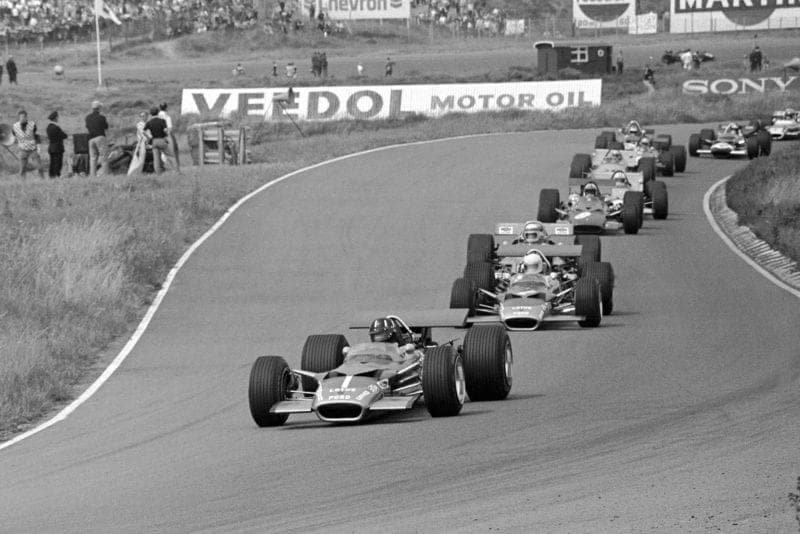
Graham Hill took the lead from team-mate Rindt at the start
Motorsport Images
Race day in Holland was Saturday, which was a change to try and attract more spectators, and whereas Friday had seen the wind turn through 180-degrees and bring rain in the afternoon, which made practice end on a dull note, Saturday was fine and dry though not clear. One thing is certain at the moment and that is that there is no team effort on Team Lotus as far as the drivers are concerned.
“Hill made one of the best starts of all time”
Lotus had their two cars on the front row of the grid, with Stewart’s Matra sandwiched between them and if ever anyone had a superb opportunity for applying team-tactics in order to control the opposition, this was it. With two drivers of the calibre of Hill and Rindt working together, even Stewart could have done nothing about it. From the starting grid to the first corner at Zandvoort is pure “drag-racing” and Hill made one of the best starts of all time, taking the right-hand corner from the left side of the road and completely blocking Rindt and Stewart, in as neat a piece of real racing as anyone could wish to see.
As the cars set off on the opening lap Team Lotus had everything nicely in their palm, with Hill first, Rindt second and Stewart third, and by driving together like Ascari/Villoresi, Collins/Hawthorn or Moss/Fangio, they could have kept Stewart in his place, for they had no other danger.
But no, they drove like Ascari v Farina or Behra v Moss and Stewart sat back and watched with disbelief as the two Gold Leaf Team Lotus drivers fought each other like petulant children and the two Lotus cars actually rubbed against each other and pushed-and-shoved as if they were in rival teams.
At the beginning of the third lap Rindt elbowed his way past his team-mate, using the sand and grass, and then proceeded to prove to everyone, especially himself, that he was faster than Hill, pulling out a ten second lead very quickly.
Stewart got by Hill and contented himself with second place, wondering if Rindt could keep up his searing pace for the full 90 laps. That we shall never know, for as he passed the pits at the end of sixteen laps, a drive-shaft universal joint broke and that was the end of Rindt’s brief glory. By this time Stewart had outpaced the rest of the field, though he had been losing nearly a second a lap to Rindt, but that did not matter anymore. The long-haired Scot had the race in his pocket and gave a splendid demonstration of fast driving with complete reliability, reeling off the laps with great regularity and lapping the slower runners, including Surtees in the 450 bhp (!) BRM.
However, he did not lap the main bulk of the field as a tremendous battle was raging for third place between Hulme, Amon, Brabham and Ickx. It had started after Stewart passed Hill, for the Lotus driver was clearly not quite as fast as those behind him, but not that much slower to justify letting them past. Siffert was the first to break loose when he did the most daring trick of all, which was to go into the wide Tarzan hairpin at the end of the straight on lap 14 so fast that he had enough speed, but only just enough control, to run round the outside of Hill and get in front by inches as they dived into the next corner.
Once past he was soon away from the pack and secure in third place, soon to take a worthy second place when Rindt retired. Hulme, Amon, McLaren, Ickx and Brabham were all nose-to-tail behind Hill and not as courageous as Siffert, so there was a procession until the Lotus headed for the pits at the end of lap 27 as the driver felt there was something coming loose in the front suspension or the steering.
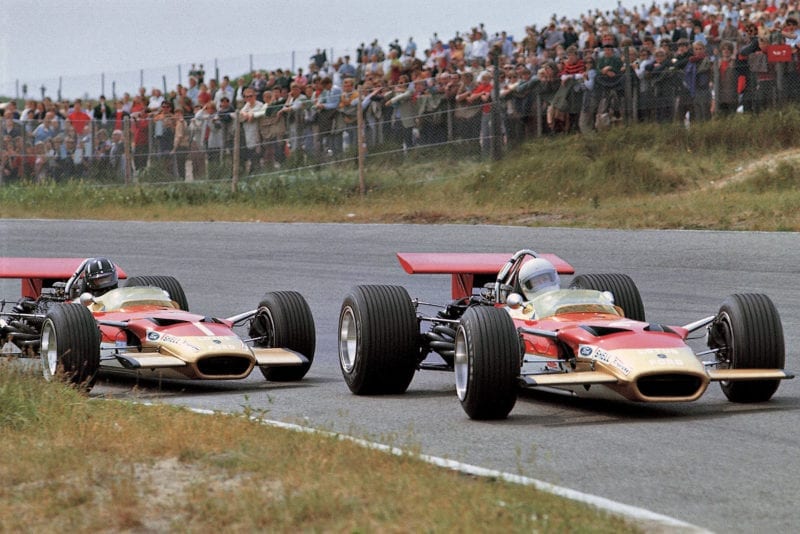
Hill chases Rindt
Motorsport Images
Nothing could be found wrong so he rejoined the race still on the same lap as the leader, a long way back, but not as far back as Surtees in the BRM. During the procession behind Hill, McLaren had been forced to drop out when a front hub-retaining bolt broke, and long before this Oliver had gone when a selector arm broke in his Hewland gearbox, and Courage had gone when his clutch burnt out on the Williams Brabham-Cosworth V8.
With a clear road ahead Hulme, Amon, Ickx and Brabham were able to indulge in a good clean battle for third place. For those who did not enjoy the sight of Stewart and the Matra dominating the race, or Siffert’s terrific effort that got him second place, apart from his enthusiastic driving which was keeping him in second place, this battle for third place was a stirring sight. It would have been a lot more impressive had it been for first place, for winning is the object of racing.
“Ickx had made a terrible start, but in his typical manner streaked up through the tail-enders”
On the starting grid Ickx had been troubled by a dragging clutch and made a terrible start, but in his typical manner he then got going properly and streaked up through the tail-enders who were Moser, Elford, Surtees and Beltoise, to join the queue behind Hill. From then on he was involved, though now handicapped by fluctuating fuel pressure which made his engine hesitate round the long fast bend onto the straight, but he joined in the battle with great spirit and when the opportunity arose he joined forces with Brabham to make things difficult for Amon or Hulme, whenever either of them came within their clutches.
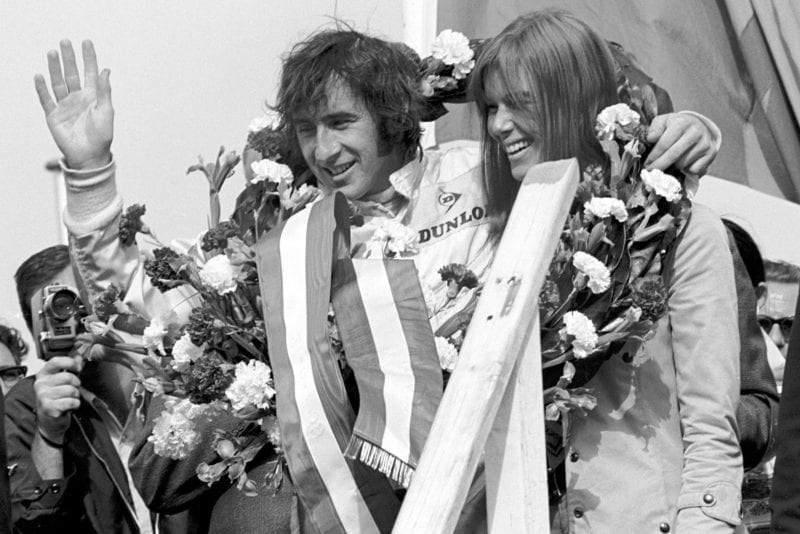
Stewart celebrates on the podium
Motorsport Images
This battle raged until lap 54, when Hulme began to assert a measurable lead over the other three and ten laps later there were two distinct pairs, Hulme/Amon and Brabham/Ickx. By lap 69 Ickx had got by Brabham and closed up on the other two, but still all four were virtually nose-to-tail. Stalemate set in as Hulme, Amon and Ickx, in that order, were equal, and Brabham began to drop back, but Hulme’s Cosworth engine was beginning to lose its fine edge, with oil pressure falling, and on lap 83 Amon got by the McLaren car to take third place. The Ferrari was twelve seconds behind Siffert’s Lotus, and though the gap reduced, there was little question of Siffert losing his well-earned second place.
Right at the end of the race, as Stewart was completing his last lap, Surtees made a surprise visit to the pits, demanding more petrol, even though his car was fitted with the outside pannier tanks. By this time he was three laps behind the winner, and set off again to finish next to last with the same deficit. At the Race of Champions last March, Stewart and Matra International showed that they were going to set the pace in 1969, and to date they have done so.
Zandvoort Azides
- Ferrari had two cars at the race, 0017 and 0019, both of which Amon drove in practice. In the race he used 0019 and Rodriguez had to stand by and watch while 0017 lay dormant. The Mexican had no Parnell-entered BRM as it was not ready in time, having a 48-valve engine installed.
- Could it be that Colin Chapman’s team should be renamed Gold Leaf Lotus, dropping the Team from the name?
- A Dutch journalist, used to Grand Prix motorcycle racing, watched Stewart and Siffert lapping severely in first and second place and said “It is rather dull isn’t it?” Could have been right?
- Elford drove Antique Automobiles Ltd.’s newly acquired maroon painted McLaren M7A-3, with the built-in pannier tanks. After the Targa Florio, Spa, Nurburgring and the Monza banked circuit he found Zandvoort a bit dull and unchallenging.
- Moser spun off the road in dramatic fashion on the first day of practice, wrecking his Brabham badly. His mechanics got it all straightened out by race day and the organisers sportingly let him have three laps try-out early on Saturday morning. His race was spoilt by ignition troubles and an excursion into the sand that clogged-up the steering.
- Ferrari issued an official hand-out the night before the race, regarding the embryo aerofoils and air spoilers, saying “Someone is cheatin’ in this here game”.
- The event was supported by the Heineken beer firm in a big way. Even to a hovercraft in the form of an enormous glass of beer on a Heineken beer mat.
